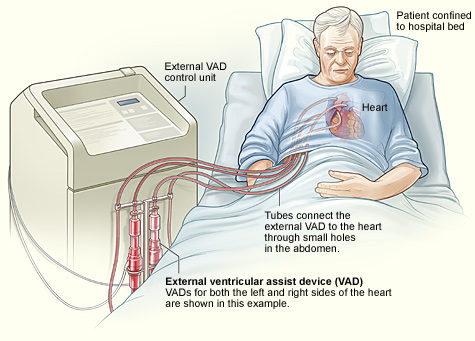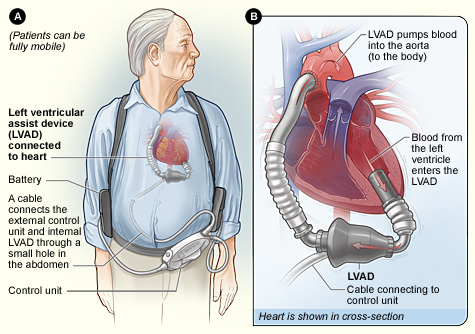What Is a Ventricular Assist Device?
A ventricular assist device (VAD) is a mechanical pump that's used to support heart function and blood flow in people who have weakened hearts.
The device takes blood from a lower chamber of the heart and helps pump it to the body and vital organs, just as a healthy heart would. (For more information about how the heart pumps blood, go to the Health Topics How the Heart Works article.)
Overview
You may benefit from a VAD if one or both of your ventricles (VEN-trih-kuls) don't work well because of heart disease. Ventricles are the lower chambers of your heart.
A VAD can help support your heart:
- During or after surgery, until your heart recovers.
- While you're waiting for a heart transplant.
- If you're not eligible for a heart transplant. (A VAD can be a long-term solution to help your heart work better.)
A VAD has several basic parts. A small tube carries blood out of your heart into a pump. Another tube carries blood from the pump to your blood vessels, which deliver the blood to your body.
A VAD also has a power source that connects to a control unit. This unit monitors the VAD's functions. It gives warnings, or alarms, if the power is low or the device isn't working well.
Some VADs pump blood like the heart does, with a pumping action. Other VADs keep up a continuous flow of blood. With a continuous flow VAD, you might not have a normal pulse, but your body is getting the blood it needs.
Research has shown that, compared with other VADs, continuous flow VADs may decrease hospital stays and complications and improve survival. However, more research is needed.
Types of Ventricular Assist Devices
The two basic types of VADs are a left ventricular assist device (LVAD) and a right ventricular assist device (RVAD). If both types are used at the same time, they're called a biventricular assist device (BIVAD).
The LVAD is the most common type of VAD. It helps the left ventricle pump blood to the aorta. The aorta is the main artery that carries oxygen-rich blood from your heart to your body.
RVADs usually are used only for short-term support of the right ventricle after LVAD surgery or other heart surgery. An RVAD helps the right ventricle pump blood to the pulmonary (PULL-mun-ary) artery. This is the artery that carries blood from the heart to the lungs to pick up oxygen.
A BIVAD might be used if both ventricles don't work well enough to meet the body's needs. Another treatment option for this condition is a total artificial heart (TAH). A TAH is a device that replaces the ventricles.
VADs have two basic designs. A transcutaneous (tranz-ku-TA-ne-us) VAD has its pump and power source located outside of the body. Tubes connect the pump to the heart through small holes in the abdomen. This type of VAD might be used for short-term support during or after surgery.
Transcutaneous Ventricular Assist Device

The image shows a transcutaneous BIVAD and how it's connected to the heart.
An implantable VAD has its pump located inside of the body and its power source located outside of the body. A cable connects the pump to the power source through a small hole in the abdomen.
Implantable VADs are used mainly for people who are waiting for heart transplants or as a long-term solution for people who can't have heart transplants.
Implantable Ventricular Assist Device

Figure A shows the location of the heart and the typical equipment needed for an implantable LVAD. Figure B shows how the LVAD is connected to the heart.
The design and type of VAD your doctor recommends will depend on your overall health, how long you'll likely need the device, and other factors.
Outlook
Until recently, VADs were too big to fit in many people's chests, especially women and children. Only people who had large chests could get them.
However, recent advances have resulted in smaller, more reliable devices. This now makes treatment with VADs an option for more people.
Researchers also have made advances in how well VADs work and how much they improve people's quality of life. In the past, VADs mostly were used for people who had end-stage heart failure. Now VADs also can help people who have earlier stages of heart failure.
Children who have heart failure also can be treated with VADs. VADs approved for use in adults sometimes are used in children if the children are large enough for the device. Also, the Food and Drug Administration recently approved a VAD designed for smaller children.
Clinical trials are research studies that explore whether a medical strategy, treatment, or device is safe and effective for humans. To find clinical trials that are currently underway for Ventricular Assist Device, visit www.clinicaltrials.gov.
The NHLBI updates Health Topics articles on a biennial cycle based on a thorough review of research findings and new literature. The articles also are updated as needed if important new research is published. The date on each Health Topics article reflects when the content was originally posted or last revised.















